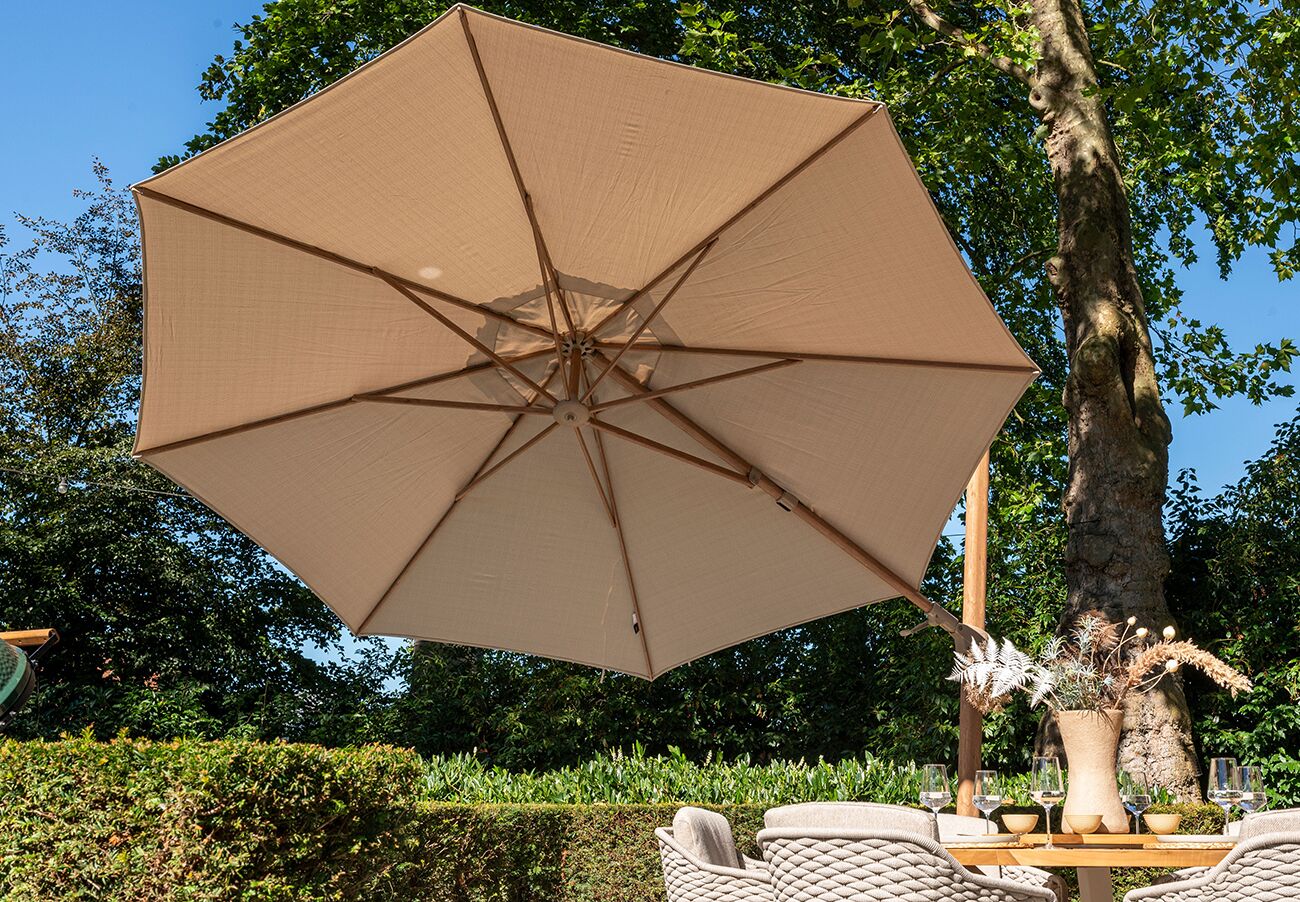No products in the basket.
The Ultimate Guide to Choosing Cantilever Garden Parasols: Enhance Your Outdoor Lounging Experience

Garden parasols are an essential part of any outdoor living space, providing shade and comfort while enhancing the aesthetic appeal of your garden. Whether you’re hosting a summer barbecue, lounging by the pool, or enjoying a meal outdoors, the right garden parasol can elevate your outdoor experience. But with a variety of parasol types available—each offering different features and benefits—it can be challenging to decide which one is best suited for your needs.
In this comprehensive guide, we’ll explore the different types of garden parasols, such as cantilever parasols, through-table parasols, and more. We’ll discuss their key features, benefits, and which outdoor furniture sets they pair best with. This guide is designed to help you make an informed decision, so you can choose the ideal parasol for your garden, patio, or deck.
Types of Garden Parasols
1. Cantilever Parasols
Overview
Cantilever parasols, also known as offset parasols, are a popular choice for modern outdoor spaces. Unlike traditional parasols, which have a central pole, cantilever parasols feature an offset side pole, allowing the canopy to hang freely over an area without obstruction. This creates an elegant, modern look and provides greater flexibility in positioning the parasol.
Key Features
- Freestanding Design: With no central pole, cantilever parasols can be positioned over large lounge sets, dining tables, or sun loungers without taking up valuable space.
- Adjustable Shade: Many cantilever parasols come with tilting or rotating mechanisms, allowing you to adjust the angle of the shade throughout the day as the sun moves.
- Versatility: These parasols are ideal for creating shaded areas over large outdoor spaces, such as patios, decks, or poolside lounging areas.
Best Suited For:
Cantilever parasols are perfect for larger garden sets, including outdoor dining sets, sectional lounge sets, or sunbed areas where flexibility is key. The freestanding design allows you to place them over seating areas without the parasol getting in the way.
Materials and Maintenance
Cantilever parasols typically come with frames made from aluminum, steel, or wood. Aluminum is rust-resistant and lightweight, while steel offers durability. Wooden frames, like teak or eucalyptus, bring a classic look but require regular maintenance to avoid weather damage. The canopy material is usually polyester, acrylic, or olefin, all of which offer UV protection and water resistance. Regular cleaning and using a parasol cover during the off-season can help extend the life of your parasol.
2. Through-Table Parasols
Overview
Through-table parasols are the most common type of garden parasol. As the name suggests, these parasols are designed to be positioned through the hole in the center of an outdoor dining table, with the pole anchored by a base beneath the table. This classic design is both functional and space-efficient, offering shade while keeping the parasol securely in place.
Key Features
- Integrated Design: The parasol sits through the center of the table, making it an ideal choice for outdoor dining sets. It provides ample shade for those seated at the table without taking up extra floor space.
- Easy to Use: Through-table parasols are straightforward to set up and operate, usually with a crank handle for opening and closing the canopy.
- Compact and Stable: With the table providing additional support, these parasols are more stable in windy conditions compared to freestanding models.
Best Suited For:
Through-table parasols are ideal for outdoor dining sets, especially in smaller gardens or patios where space is limited. They’re perfect for bistro tables, family-sized dining sets, or even compact balcony setups.
Materials and Maintenance
These parasols typically come in a range of materials for both the frame and canopy. Aluminum frames are lightweight and rust-resistant, while wooden options add a more traditional look. Polyester and acrylic canopies are popular for their durability and UV protection. Maintenance is relatively simple—keep the canopy clean and store the parasol in a protective cover when not in use.
3. Wall-Mounted Parasols
Overview
Wall-mounted parasols are a unique option for those with limited floor space. These parasols are fixed to a wall or other vertical surface, extending outward to provide shade without the need for a pole or base. This is a great solution for small patios, balconies, or decks where floor space is at a premium.
Key Features
- Space-Saving Design: The lack of a pole or base means you can maximize your outdoor floor space while still enjoying ample shade.
- Adjustability: Most wall-mounted parasols can be tilted or rotated to adjust the shade throughout the day, providing excellent coverage for a range of outdoor areas.
- Easy Installation: Wall-mounted parasols are relatively easy to install and remove, making them a flexible option for seasonal use.
Best Suited For:
These parasols are ideal for small outdoor spaces like balconies or compact patios, especially in urban environments. They work well when paired with small dining sets, bistro sets, or even sun loungers in narrow spaces.
Materials and Maintenance
Wall-mounted parasols typically feature aluminum or steel frames for durability, with canopies made from polyester or acrylic fabrics. They require minimal maintenance beyond regular cleaning, and it’s essential to check the wall mounting for stability periodically.
4. Tilting Parasols
Overview
Tilting parasols offer additional flexibility by allowing you to tilt the canopy to different angles, providing optimal shade coverage as the sun moves across the sky. This makes them particularly useful in gardens or patios where direct sunlight varies throughout the day.
Key Features
- Adjustable Shade: The tilting mechanism enables you to angle the canopy as needed, ensuring continuous shade without the need to move the parasol.
- Various Sizes: Tilting parasols are available in a range of sizes and shapes, making them versatile enough to fit different outdoor setups.
Best Suited For:
Tilting parasols are a great option for lounging areas, smaller patio spaces, or dining sets where sun exposure changes frequently throughout the day. They work well with a variety of furniture setups, including sun loungers, bistro sets, and sectional sofas.
Materials and Maintenance
These parasols often come with aluminum or wooden frames, and the canopy can be made from UV-resistant polyester or acrylic. The tilting mechanism should be checked regularly for smooth operation, and as with other parasols, it’s important to clean and protect the canopy when not in use.
Additional Considerations When Choosing a Garden Parasol
1. Base and Stability
Regardless of the type of parasol you choose, ensuring stability is crucial. Cantilever parasols require heavy-duty bases, often filled with water or sand, to counterbalance the weight of the canopy. Through-table parasols typically use a base under the table, but it’s still important to choose one that offers adequate weight and stability, particularly in windy conditions.
2. UV Protection and Water Resistance
Many parasol canopies are designed to offer UV protection, but not all provide the same level of coverage. Look for parasols that specify a UPF (Ultraviolet Protection Factor) rating to ensure adequate sun protection. Additionally, water-resistant canopies are a must in climates prone to unexpected rain showers.
3. Color and Style
While functionality is key, the color and style of your parasol should also complement your existing outdoor furniture and overall garden aesthetic. Neutral tones like beige, grey, or taupe are versatile and work well with most garden furniture sets, while bold colors like red, green, or navy can add a pop of personality to your outdoor space.
Conclusion
Garden parasols come in various shapes, sizes, and designs, each offering unique benefits depending on your outdoor space and furniture setup. Whether you’re looking for the flexibility of a cantilever parasol, the classic design of a through-table parasol, or the space-saving features of a wall-mounted option, there’s a parasol out there to suit your needs. By considering factors such as size, material, stability, and style, you can choose the perfect parasol to enhance your outdoor lounging experience and protect you from the sun all summer long.
